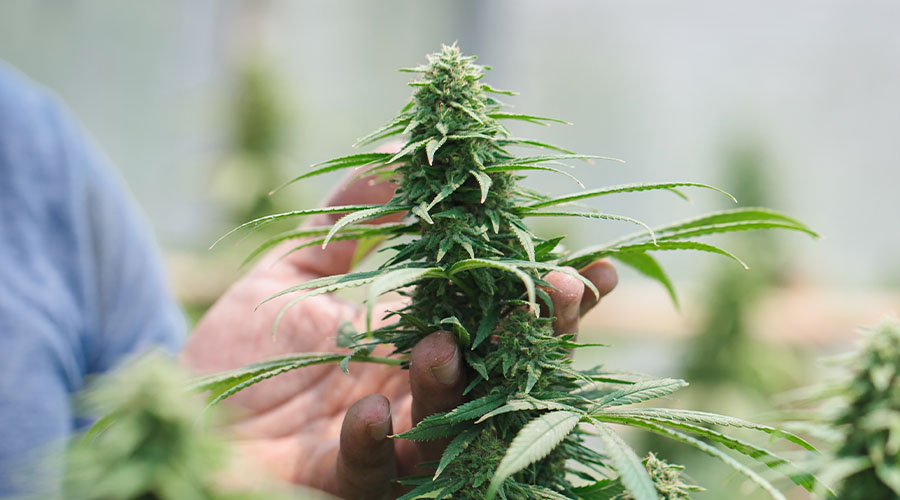“Reveg weed” is a term used when marijuana plants are in the flowering stage, then mysteriously revert back to the vegetative stage.
But is re-vegging good? Is it bad? Can it be stopped? What does it all mean?
Find out below in this informative article about what to do when your cannabis plants reveg.
What Is Re-Vegging?
Contrary to common belief, re-vegging cannabis is more of a natural phenomenon than a cultivation technique. The phrase refers to a process whereby a cannabis plant re-enters the vegetative phase after it is mature and has produced budding flowers.
Different Types of Re-Vegging in Cannabis
Different types of re-vegging processes can occur in cannabis plants. Here are some of the most common:
Post Harvest Re-Vegging
This refers to cannabis plants that are cut down for harvest and then regrown to produce a new batch. Producing post-harvest re-vegged cannabis is 100% doable and a lot easier than most growers think.
After you harvest buds from your mature plants, they will start producing new veg sites on their own, so long as the plants are healthy and remain in an environment conducive to growth.

Remember, mature bud sites are produced when the plants think the days are getting shorter and winter is coming. This is why you cut your lighting schedule almost in half to initiate flowering.
When you re-veg your plants, you want them to think it’s spring, meaning the days are getting longer and the sunlight is becoming more intense. Adjust your lighting schedule to provide 18–24 hours of light per day, just like in a regular vegetable state.
This extended light period will signal the plant to revert to the vegetative stage and can easily be achieved using artificial grow lights.
Monster-Cropping Clones
Monster cropping is a cloning technique where a grower takes clippings from a harvested plant and then roots them, placing them directly into the vegetative stage.
If done successfully, the technique can quickly return rooted plants to the flowering stage, thereby creating a “monster crop.”
Mature monster crop plants often exhibit odd characteristics, such as long, skinny branches and a high volume of erratically placed flower sites. These characteristics lead to higher yields, which is the ultimate goal of any monster cropping technique.
Accidental Re-Vegging
Accidental reveg is the most common type of re-vegging in cannabis. Typically, a grower will have successfully entered the late flowering stage and will be anticipating harvest when they start to notice new leaf sites on the branches of their plants.
The most common cause of this is over-nutrifying, which occurs when plants receive too much water, sunlight, and/or nutrients. Put another way, the plants think they should be growing rather than reproducing (producing flowers).
This is why it’s so important to reduce your lighting and watering schedules as your plants enter the flowering stage.
Benefits of Re-Vegging Cannabis Plants
Let’s check out three of the upsides of re-vegging.
Eliminate Mother Plants
One of the only benefits of re-vegging cannabis plants is that it eliminates the need for mother plants in a crop. Rather than keeping a single plant for cloning, a grower will clone from a young, healthy vegging plant. This prevents the occurrence of genetic mutation (and subsequently disease) in F1 generations.
Increase Yields
Some growers claim that re-vegging can increase yields since the plant that’s being re-vegged has a well-established root system. Indeed, re-vegged marijuana plants will produce multiple new shoots, and they often yield a robust canopy with numerous flowering sites. Re-vegging is also commonly used to try to rejuvenate a harvested plant for continued flowering stages.
Cloning a Phenotype
Technically speaking, any cutting that is re-vegged is going to be a clone of its mother plant. This is for obvious reasons, given that the re-vegged plant (and subsequent flowering sites) will have the exact same DNA as the plant that was harvested prior to re-vegging.
Downsides to Re-Vegging Cannabis
Before you begin, take note of the following issues associated with re-vegging.
Smaller Yields
You don’t hear much about the potential benefits of re-vegging because, more often than not, the technique results in smaller yields rather than larger ones.

There are numerous theories as to why this is the case, but our philosophy is simple. Like humans or any living entity, plants start to lose vigor and fertility as they age. In most instances, a single cannabis plant will not produce the same volume of yields in F2, F3, etc. generations as it did in its first generation of offspring.
Stress on the Plant
Any time you re-veg a plant, you’re putting an immense amount of stress on its energy resources. Of course, this can negatively impact cannabis maturation and flowering. Stress diverts energy away from bud development and compromises overall health, resulting in lower yields.
Summary of Re-Vegging Cannabis
Re-vegging is a unique process in which a plant in the flowering stage goes back to the vegetative stage. This process can be extremely frustrating for growers, as it generally means a plant is confused and will stop producing flowering bud sites.
That being said, the technique can, (under rare circumstances, be advantageous for flower yields. However, in order to reveg weed successfully, a grower must be able to understand and navigate factors such as stress, lighting, root maturation, and so forth.

![Why Are My Cannabis Leaves Turning Yellow? [Explained]](https://wayofleaf.com/wp-content/uploads/2020/08/wol-banner-why-are-my-cannabis-leaves-turning-yellow-640x225.jpg)


![8 Tips for Cultivating Harlequin Marijuana [Growers Guide]](https://wayofleaf.com/wp-content/uploads/2019/01/wol-banner-8-tips-for-cultivating-harlequin-marijuana-640x225.jpg)



![8 Tips for Growing Super Lemon Haze Cannabis [Grower’s Guide]](https://wayofleaf.com/wp-content/uploads/2018/10/mj_tips-for-growing-super-lemon-haze-640x225.jpg)

![8 Tips for Growing Jack Herer Cannabis [Guide]](https://wayofleaf.com/wp-content/uploads/2019/04/wol-banner-8-tips-for-growing-jack-herer-cannabis-640x225.jpg)

